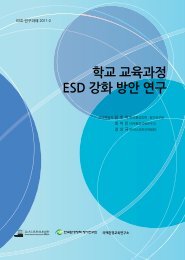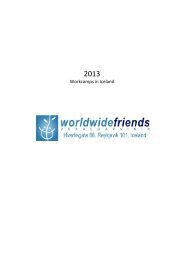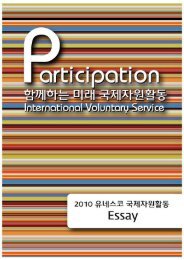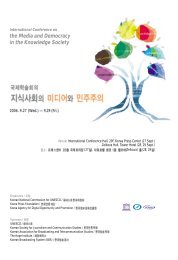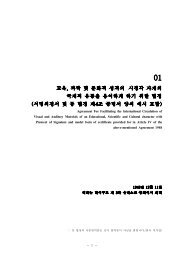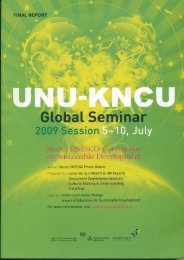Untitled
Untitled
Untitled
You also want an ePaper? Increase the reach of your titles
YUMPU automatically turns print PDFs into web optimized ePapers that Google loves.
Section 1. The Pipeline of Green Growth: Green Talent<br />
While the codes for the Kim Dae-jung and Rho Moo-hyun government were<br />
People and Participatory government, the code for the present government is “green”<br />
as it emphaiszes “green growth.” Ever since the President explicitly mentioned<br />
“green growth” in the presidential address on the anniversary of Liberation Day,<br />
August 15 in 2008, a green growth model has been suggested by the government,<br />
and relevant proposals were quickly made. “Green growth” has not only been<br />
emphasized in Korea, but it has also been a global code that explains the 21 st<br />
century. It was selected as a development model of the 21 st century in the Asia-<br />
Pacific region according to the UNESCAP (United Nations Economic and Social<br />
Council for Asia-Pacific) Declaration. There is also a high interest toward green jobs<br />
and technology in international organizations such as ILO and OECD. The<br />
establishment of the Green Jobs Act in the U.S. shows this. There are some cynical<br />
perspectives of green growth; it is not a new idea and there has been efforts of the<br />
intellectuals and international organizations that claimed the importance of<br />
environment-friendly sustainable development since the 1970s (Lee, 2009). However,<br />
recent efforts to include green growth into national policies in Korea and other OECD<br />
countries prove that environmental problems have entered a critical stage where a<br />
more comprehensive consideration of the environment and economics is necessary,<br />
and it has become something that is beyond the rhetoric of the liberals. The Global<br />
warming and melting glaciers, Hurricane Katrina and the 2004 Tsunami showed us<br />
the tragic result of global warming, depletion of petroleum and natural gas and the<br />
intensifying political and economic conflicts due to the depletion of resources. These<br />
all indicate that green growth model is an inevitable choice for human beings to<br />
survive. Therefore, despite the fact that it is late, we still need to actively support<br />
the Green Growth model so that it can be properly implemented.<br />
The defintion of Green Growth and the specific range and contents of the<br />
Green Growth policy model is still controversial and not yet organized. Some<br />
interpret Green Growth as another economic development model with a new growth<br />
source based on low carbon and environment-friendly technology, while others<br />
interpret it as a new paradigm of social development and life that prioritize the<br />
environment despite the inconvenience due to less consumption and slow pace.<br />
Whether green growth is interpreted in a narrow or broad sense, the issue of<br />
educating human resouces that leads green growth is the core task of green growth.<br />
This is not only because the “human” element is an important element in every<br />
growth model but also because the core power of implementing green growth<br />
depends on the creation and utilization of high quality human resources that is<br />
appropriate for “Green Growth.” Also, it is because change in consciousness,<br />
attitude and people’s life styles toward society and the environment is necessary to



